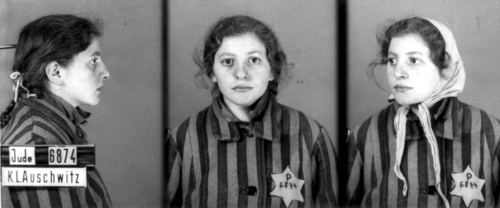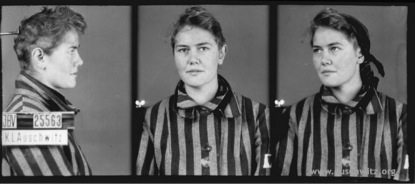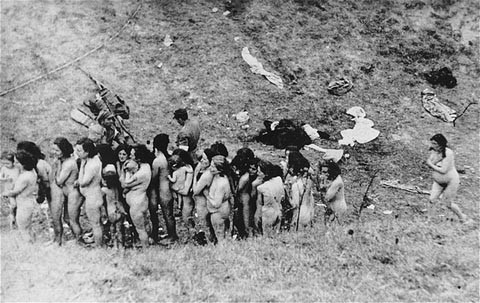 HCH 20 / January 2018
HCH 20 / January 2018
We Remember, by Antonia Tejeda Barros

Only 76 years ago, in the heart of Europe, Germany (one of the most educated countries in the world) carried out a genocide against millions of Jewish men, women, and children, and thousands of Roma and Sinti men, women, and children in the most planned and brutal way (gassing and shooting). Germany also killed 2 million Poles and 2 million Soviet POWs (Prisoners of War), 5,000–15,000 homosexuals (men), 1,650 Jehovah Witnesses, and 70,000–250,000 non Jewish German and Austrian people suffering from disabilities through Aktion T4.
The Holocaust was produced thanks to the willing and cooperation of 90% of the German population. Friedrich Kellner wrote in his diary in December 1941: “This cruel, despicable, and sadistic treatment against the Jews that has lasted now several years — with its final goal of extermination — is the biggest stain on the honor of Germany” (Vernebelt, verdunkelt sind alle Hirne / My Opposition). Yehuda Bauer, one of the most important Holocaust historian, confirms the collaboration of the vast majority of Germans in the Holocaust: “Goldhagen is absolutely right when he insists … that by 1940 – 1941 German society had become a reservoir for willing executioners (…) Goldhagen has an argument with Christopher R. Browning over what percentage of Germans were potentially or actually willing to participate in the genocide. Browning believes that the percentage of policemen examined who were opposed to murder was 10 to 20 percent: Goldhagen says 10 percent of all Germans were opposed. In either case, the statement that the vast majority of the German population were willing to be recruited for the murder of Jews stands” (Rethinking the Holocaust, pp. 102, 103).
Between 1933 and 1945 exclusion, humiliation, deportation and murder took place thanks to the collaborations of millions of Germans. Millions of men, women, and children were shot, gassed and burnt alive. It happened little time ago. The vast majority of murderers were never even tried and many murderers are still alive. They live in Germany, Austria or South America, and will die at home happy and free. Their victims went through the crematoriums of the six extermination camps built by Germany or remain in some pit. There will never be justice for them. Only silence.
“[The Germans] will never be able to erase these crimes”, wrote Kellner in 1941. But the truth is that Germany has already forgotten its horrible crimes. The Germany of today wants to treat the Holocaust as something from the far away past, perpetrated by 10 crazy Nazis who, completely on their own, killed millions and millions of innocent people. Yeah, right.
Today Germany pretends to be a tolerant country, but let’s not forget that only 76 years ago almost the whole country collaborated in the exclusion and humiliation that led later on millions of innocent people to their deaths. Today Germany pretends to be an eco friendly country, but let’s not forget that only 76 years ago almost the whole country created a perfect organized killing machine to exterminate millions of innocent men, women, children, and babies in huge gas chambers. Today Germany pretends to be a just country, but let’s not forget that after the war Germany did the minimum or nothing at all to prosecute its German fellow murderers. Let’s not forget. Because if we forget, it will happen again.
We remember the 6 million Jewish men, women, and children.
We remember the 250,000 Roma and Sinti men, women, and children.
We remember the 2 million Poles.
We remember the 2 million Soviet POWs.
We remember the 5,000–15,000 homosexuals.
We remember the 1,650 Jehovah Witnesses,
We remember the 70,000–250,000 non Jewish German and Austrian mentally and physically disabled people.
We remember the war and the 70 million people who died in the war.
We remember the horror, the atrocities, the collaboration, the betrayal, the pits full of corps, the gas chambers, the extermination camps, the mothers with the babies, the fear, the injustice, the colossal barbarity, the ruins, the screams, the silence.








































#WeRemember #WeRemember #WeRemember #WeRemember
#WeRemember #WeRemember #WeRemember #WeRemember
 Antonia Tejeda Barros, Madrid, January 24, 2018
Antonia Tejeda Barros, Madrid, January 24, 2018
More articles by Antonia Tejeda Barros in Antonia’s corner
PHOTOS
I. The Gate of Death, entrance to Auschwitz-Birkenau. Stanisław Mucha. Auschwitz-Birkenau State Museum
II. Gas pellets of Zyklon B. Loboda, 1968. Auschwitz-Birkenau State Museum
III. Four gypsy girls used in medical experiments in Auschwitz by Mengele. None survived. Photo by Wilhelm Brasse. Auschwitz-Birkenau State Museum
IV. David Olère. Guetto Fighter’s House Museum
V. David Olère. Dans la salle de déshabillage, 1946. Guetto Fighter’s House Museum
VI. David Olère. Après le gazage, 1946. Guetto Fighter’s House Museum
VII. David Olère. Dans la salle des fours, 1945. Guetto Fighter’s House Museum
VIII. The Auschwitz Album. Yad Vashem
IX. The Auschwitz Album. Yad Vashem
X. The Auschwitz Album. Yad Vashem
XI. The Auschwitz Album. Yad Vashem
XII. The Auschwitz Album. Yad Vashem
XIII. The Auschwitz Album. Yad Vashem
XIV. Gas chamber. Auschwitz I. Auschwitz, 1945. Dokumentationsarchiv des Oesterreichischen Widerstandes. USHMM
XV. The Auschwitz Album. Yad Vashem
XVI. The Auschwitz Album. Yad Vashem
XVII. Glasses from the victims of Auschwitz. Auschwitz, 1945. USHMM
XVIII. Hair from the victims of Auschwitz. Auschwitz, 1945. USHMM
XIX. Clothes from the victims of Auschwitz. Auschwitz, 1945. Auschwitz-Birkenau State Museum
XX. Shoes from the victims of Auschwitz. Auschwitz, 1945. Auschwitz-Birkenau State Museum
XXI. Sonderkommando burning corpses. Auschwitz, summer of 1944. Yad Vashem
XXII. Jewish girl. Number 6.874. Wilhelm Brasse. Yad Vashem
XXIII. Jewish girl. Number 7.537. Wilhelm Brasse. Yad Vashem
XXIV. Jewish girl. Number 7.544. Wilhelm Brasse. Yad Vashem
XXV. Polish Jewish man. Number 21.904. Wilhelm Brasse. Yad Vashem
XXVI. Polish Jewish man. Number 21.980. Wilhelm Brasse. Yad Vashem
XXVII. Polish girl. Czesława Kwoka. Number 26.947. Wilhelm Brasse. Yad Vashem
XXVIII. Dutch woman. Jehovah Witness. Number 25.563. Wilhelm Brasse. Yad Vashem
XXIX. Gypsy (Roma) girl. (Z=Zigeuner). Number 63.598. Wilhelm Brasse. Yad Vashem
XXX. Judenstern of a German Jew. 1942–1945. USHMM
XXXI. Two little Lithuanian Jewish boys: Emanuel Rosenthal (2 years old) and Avram Rosenthal (5 years old) in the Kovno ghetto. They were deported to Majdanek and gassed upon arrival. Kovno ghetto, 1944. USHMM
XXXII. Naked women hugging their babies before being shot by Einsatzgruppen. Mizocz’s massacre, October 14, 1942 / Instytut Pamieci Narodowej. USHMM
XXXIII. Jewish mother hugging her little daughter while an Einsatzgruppe shoots them in the head. Ivangorod’s massacre, Ukraine, 1941–1943. Yad Vashem
XXXIV. Buchenwald. Survivors. Buchenwald, April 16, 1945. Photo by Harry Miller. USHMM
XXXV. American soldiers watch the corpses in Buchenwald. After the liberation. April 1945. Fotoarchiv Buchenwald© Gedenkstätte Buchenwald und Mittelbau-Dora
XXXVI. Three children survivors: Romek Wajsman (prisioner number 117098), Janek Szlajtsztajn (prisioner number 116543), and Dawid Perlmutter (prisioner number 116730). Buchenwald. After the liberation. Fotoarchiv Buchenwald © Gedenkstätte Buchenwald und Mittelbau-Dora
XXXVII. Children survivors. Auschwitz, 1945. Auschwitz-Birkenau State Museum
XXXVIII. Children survivors. Auschwitz, 1945. Auschwitz-Birkenau State Museum
XXXVIX. Baby survivor tattooed. Auschwitz, 1945. Auschwitz-Birkenau State Museum
IL. Children survivors. Auschwitz, 1945. Auschwitz-Birkenau State Museum
PHOTO CREDITS
Auschwitz-Birkenau State Museum
United States Holocaust Memorial Museum (USHMM)
Yad Vashem. The World Holocaust Remembrance Center
Los Angeles Museum of the Holocaust (LAMOTH)
Gedenkstätte Buchenwald und Mittelbau-Dora
Auschwitz. No hace mucho. No muy lejos
You must be logged in to post a comment.